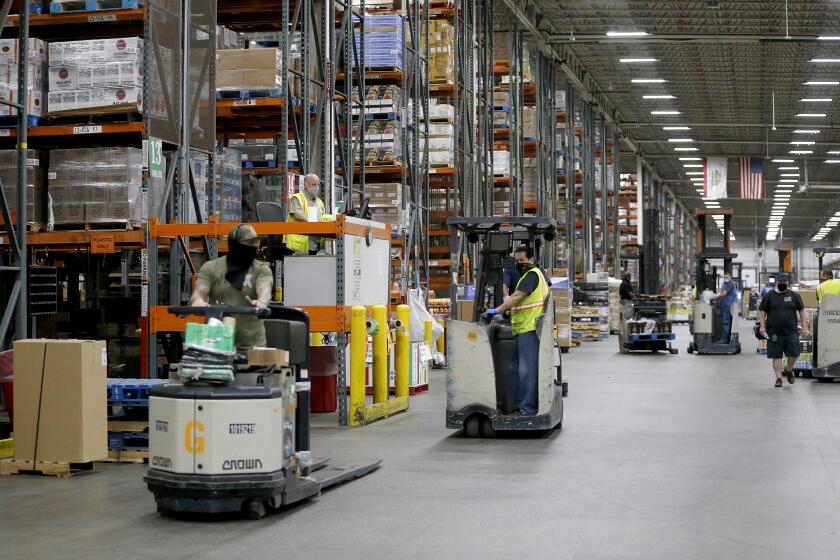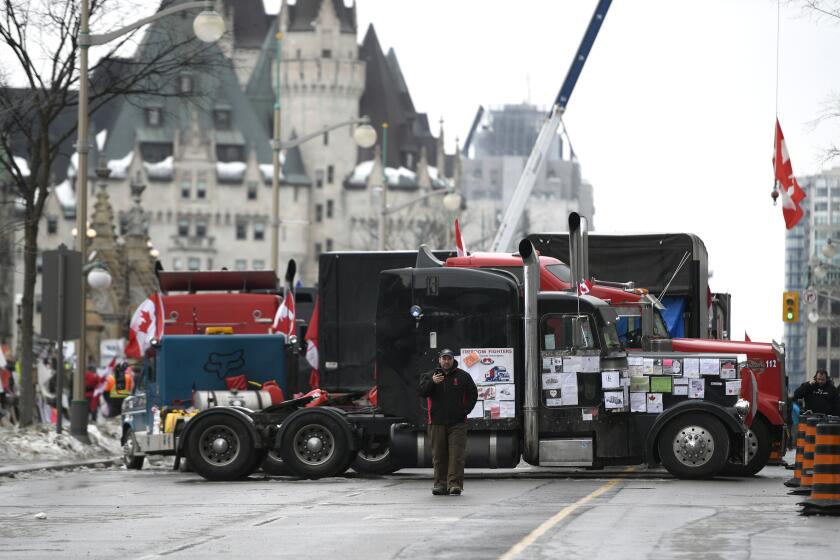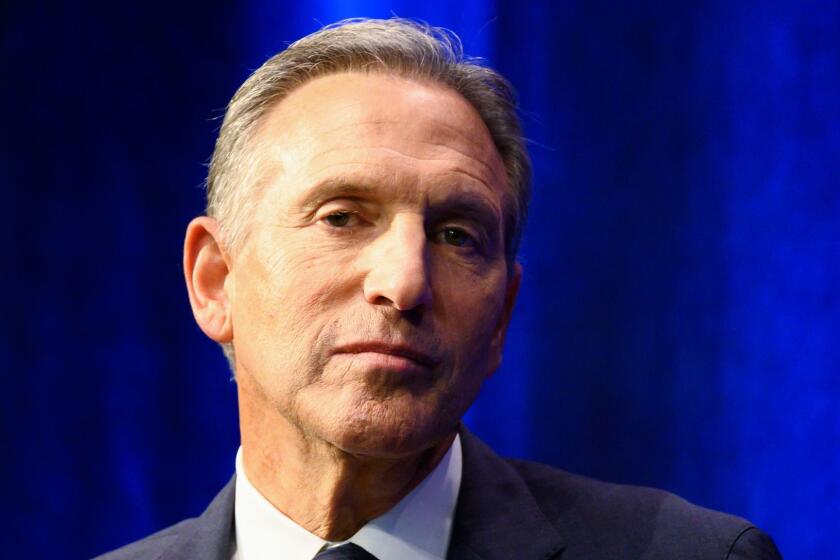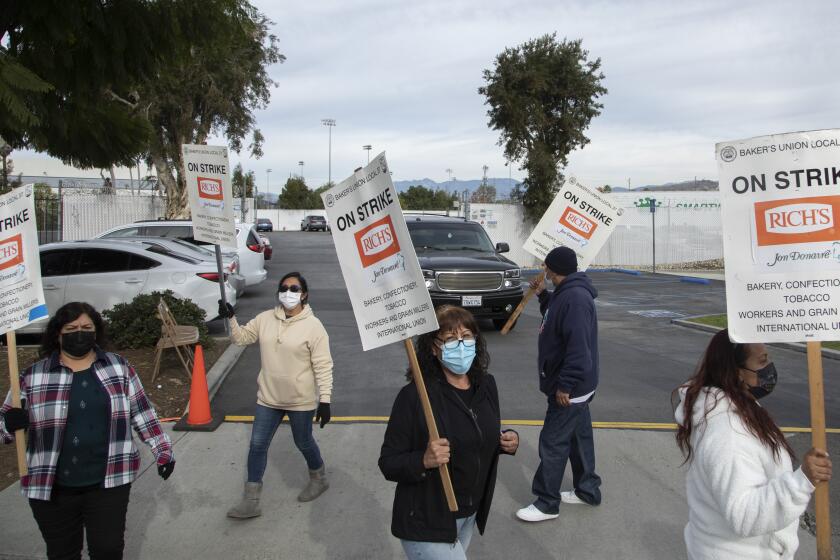Column: Why Starbucks has become a huge unionization target — and why the company is in a panic
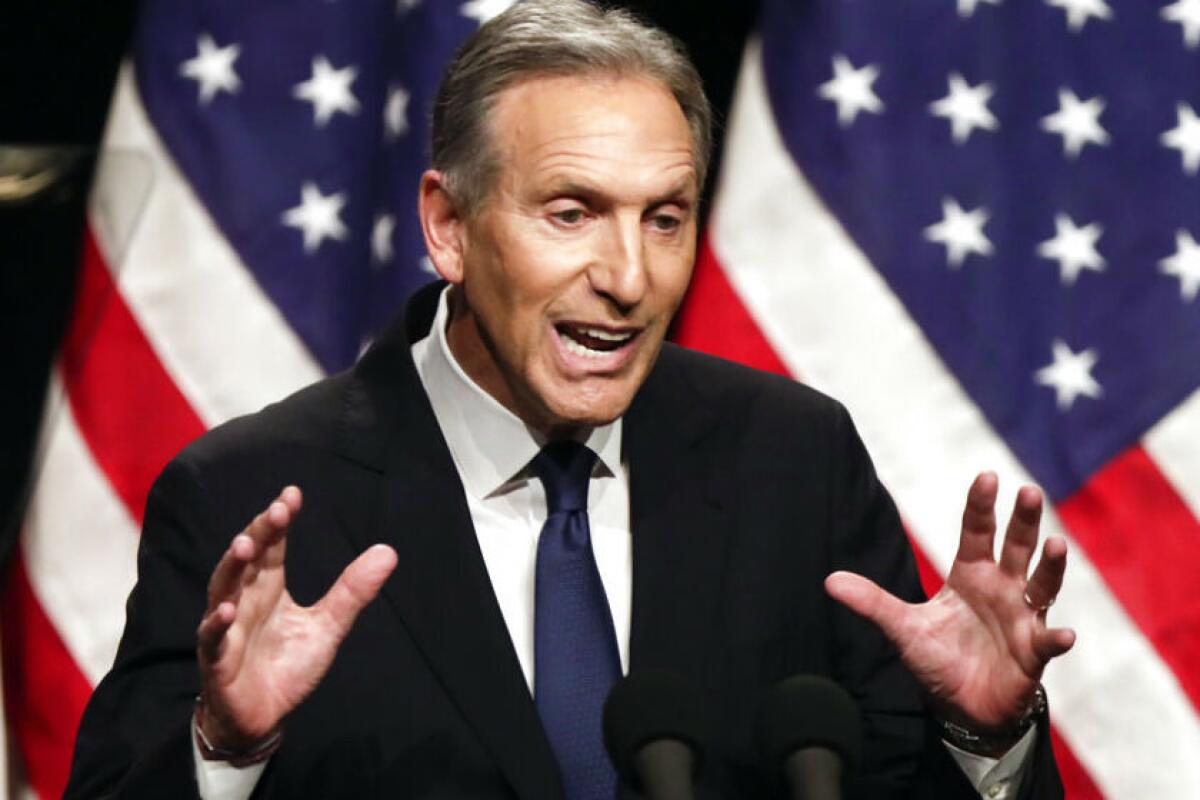
- Share via
On April 7, Madison Hall, a barista and union organizer at the Starbucks store on Long Beach’s bustling 2nd Street commercial strip, was invited to a session the next day to “meet with and co-create with upper-level management,” Hall says.
The time and location of the meeting had been kept secret until then. Hall, 25, who has worked at Starbucks since June 2020, figured that it was part of a grand tour that Howard Schultz, who had just been named to his third stint as the company’s CEO, had begun with Starbucks employees around the country.
Outside labor unions are attempting to sell a very different view of what Starbucks should be.
— Starbucks CEO Howard Schultz, attacking organized labor
It’s reasonable to say that this session, at a conference facility near Long Beach Airport, didn’t go the way Starbucks brass expected.
Hall says that Schultz became increasingly irritated as Hall brought up the unfair labor practice complaints that the company has faced before the National Labor Relations Board.
Get the latest from Michael Hiltzik
Commentary on economics and more from a Pulitzer Prize winner.
You may occasionally receive promotional content from the Los Angeles Times.
That was at odds with his evident goal of presenting Starbucks as a nurturing company for its workforce and himself as the nurturer-in-chief in order to stave off a growing unionization drive at the company’s locations.
Schultz kept refusing to discuss the NLRB matters, Hall says. Finally, Hall says, he snapped: “If you hate Starbucks so much, why don’t you go somewhere else?”
(We’ve asked Starbucks to give its version of the exchange, but have not heard back.)
Many American consumer companies, including Amazon and McDonalds, have been dealing with a surging interest in unionization by their employees, spurred in part by the pandemic-driven recognition that their employers have consistently undervalued their contributions to business success.
But few such union drives are as high-profile as the one at Starbucks. One reason may be the company’s warm and comforting image and its efforts to project a friendly relationship between customers and workers, who are designated in company parlance as “partners.” That’s very much at odds with the image of an employer so cold to the welfare of its workers that they’re spurred to organize.
Employers’ gratitude for their ‘hero’ workers didn’t last long
Another may be the rapidity of the unionization drive’s expansion, which began with pro-union votes at three Buffalo-area stores. Workers United, an affiliate of the Service Employees International Union that is organizing union votes, says 223 Starbucks locations in 31 states have filed for votes with the NLRB.
That’s a fraction of the roughly 9,000 company-operated stores in the U.S., but reports of new successful votes are streaming in on virtually a daily basis. Five stores in the Richmond, Va., area voted for unions by overwhelming margins on April 19 alone, and workers at the company’s Seattle Reserve Roastery, a flagship tourist draw in Starbucks’ home city, announced a successful vote on April 21.
Workers United says 28 Starbucks stores have now voted to unionize, up from nine that had done so as of April 1.
“Because Starbucks is a front-facing company considered ‘essential,’” Workers United organizing chief Richard Minter says, “the pandemic exacerbated the employer-employee relationship. The partners were left in the crosshairs without the resources necessary to handle what was happening, without the right precautions and protocols that allowed them to feel safe.”
The company has mounted a fierce counterattack against the organizing drive. In videotaped town hall presentations, written communications to workers and managers, and in meetings with workers around the country, Schultz has repeatedly characterized unions as a menace to the company’s economics and future.
“Outside labor unions are attempting to sell a very different view of what Starbucks should be,” he wrote in an open letter posted on the company’s website April 10.
Employees “supporting unionization are colluding with outside union forces,” he wrote. “The critical point is that I do not believe conflict, division and dissension — which has been a focus of union organizing — benefits Starbucks or our partners.”
In a video call to managers leaked to union representatives, Schultz called unions “an outside force that is trying to disrupt the future of our company... an outside force that’s going to dictate or disrupt who we are and what we do.”
Truck drivers are getting smeared by circumstances beyond their control. They need your support.
Schultz asserted that the number of employees who have voted for unionization is a bare minority, because anti-union workers have not cast a vote — in part, he asserted, because they had been bullied against voting by pro-union workers. Under NLRB rules, election results are based on the percentage of votes cast, not the percentage of vote-eligible workers.
The union threat, Shultz said in a town hall meeting shortly after his reappointment as CEO, extends beyond Starbucks: “Companies throughout the country [are] being assaulted in many ways by the threat of unionization.”
Starbucks, in an anti-union FAQ posted on its website, warns that “unions get their revenue from dues, which could come out of your pay each week or month.” It says, “unions use dues to pay for their office overhead, staff salaries and other expenses,” though it doesn’t mention the expense of negotiating contracts and enforcing their provisions, which are of course the chief duties of unions.
The company also has hired the law firm of Littler Mendelson, which boasts of its skill at guiding companies “in developing and initiating strategies that lawfully avoid unions.” These include advising management on “precise and compliant messaging to employees ... that may include informational signs and posters, home letters, meeting materials, testimonial videos, social media postings, handouts and campaign websites.”
Followers of labor-management relations will recognize that Schultz’s words come directly out of the canonical corporate anti-union playbook:
Paint the unions as “outsiders.” Imply that their only goal is to add members. Say they’ll disrupt the smooth working of the company or even drive it out of business. Say they’ll make it impossible for workers to deal directly with management. Talk about how much money workers will lose to dues.
Martin Jay Levitt, who plied this trade for 20 years, laid all this out in his indispensable 1993 book “Confessions of a Union Buster.” He wrote about describing unions to workers “as a self-serving outsider,” while presenting management as “humble, caring, righteous” and warning that union activities would “ruin the company and jeopardize jobs.”
What is it with plutocrats and voting?
For union busters like himself, Levitt wrote, “The enemy was the collective spirit” that guided organizing drives: “I got hold of that spirit while it was still a seedling; I poisoned it, choked it, bludgeoned it if I had to, anything to be sure it would never blossom into a united workforce, the dreaded foe of any corporate tyrant.”
Starbucks is plainly aware of the complaints about pay and working conditions that are fueling the organizing drive. The company has displayed on its website a poster it says reflects “issues we have been hearing from partners.”
Among them are “dealing with more difficult customers than ever before,” stores that are chronically short-staffed,” shift assignments that are “so unpredictable, I can’t plan anything else in my life,” reduced hours and inadequate pay. Hall says that Long Beach baristas have complained about a lack of security in and around their stores and that their pay, which averages around $17 to $18 an hour, isn’t enough to make ends meet in the high-cost environment of Southern California.
Hall acknowledges that some Starbucks benefits are good, including healthcare coverage for part-timers, but says that workers’ hours have been getting cut — almost to the point where they might not reach the 20-hour weekly minimum that makes them eligible for those benefits. “We’ve been operating at the bare minimum of people we can have on the floor,” Hall told me. “We’re not being given enough people to ensure that our store is stocked and clean.”
A nearly three-month strike shows the determination of low-wage factory workers.
Starbucks is not new to the arena of fraught labor relations. Its animosity toward unions dates back to Schultz’s 1987 acquisition of the company, then a local chain of coffee spots in Seattle. At that time, Starbucks employees were represented by the United Food and Commercial Workers Union. Former workers say Schultz promised to honor the UFCW contract but almost immediately tried to renegotiate it.
As part of his self-presentation as a caring boss, Schultz has claimed that he was the first executive to grant part-time workers health coverage, but that’s misleading: The provision was part of the UFCW contract negotiated before his arrival, and matched similar benefits the union had secured for grocery workers and other members across the Puget Sound region.
(Starbucks spokesman Reggie Borges told me that Schultz means that he was the first to bring those benefits to a nationwide workforce, but in fact union contracts across the country provided for part-timer benefits.)
In 2010, the National Labor Relations Board charged Starbucks with a raft of violations of federal labor law in connection with its attack on an organizing effort in Manhattan by the Industrial Workers of the World. Among the charges were that the company discriminated against pro-union employees at the stores, prohibited workers from discussing the union or their working conditions, and fired two pro-union workers.
As an appellate court panel later observed, the company didn’t challenge the NLRB’s determination that its actions were illegal. The appeals judges upheld the firing of one of the workers for reasons other than his union activities, and sent the other firing back to the NLRB for further consideration. The NLRB again ruled the second firing illegal and ordered the company to reinstate the worker with back pay.
The latest unionization drives have generated new NLRB charges. Last July, an NLRB administrative law judge found that the company had illegally spied on Philadelphia workers engaged in the unionization effort and fired two of them “in an attempt to quell the organizing drive.” Last month, the agency charged Starbucks with illegal anti-union activity in Phoenix, where it alleges the company spied on union supporters among its workers and suspended one union organizer and forced another to quit, allegedly because of their union activities.
Starbucks, wrote NLRB Phoenix Regional Director Cornele A. Overstreet in the agency complaint, “has been interfering with, restraining, and coercing employees” in the exercise of their legal rights to engage in union drives.
The company is entitled to appeals and hearings in both cases. “We have not retaliated against any partner for their interest in unionization,” Borges told me by email. “Any such claims are categorically false.”
The company last week filed complaints with the NLRB charging Workers United with unfair labor practices, alleging that its representatives have bullied and intimidated workers in Denver and Phoenix. Those charges haven’t yet been taken up by the agency.
It’s conceivable that Schultz honestly sees himself as the hand that can improve Starbucks’ relationship with its workers, and that unions will only get in the way. He’s adept at projecting sincerity, as when he says in an employee video of the worker meetings that “it was difficult and emotional at times to hear the challenges and the issues that partners are facing.”
Unlike some other companies, Starbucks has not turned a cold shoulder to unions that have been voted in at its stores; Workers United says the company has begun to meet with union representatives at two of the Buffalo stores that touched off the organizing trend, though they have not reached contracts.
The real question is whether the company will draw the right lessons from the union organizing drive: that unions and management can be partners, not invariably adversaries, that demonizing unions won’t improve labor relations, and that workers’ interest in unionization doesn’t mean they hate the company.
Hall says that seeing the success of the organizers in Buffalo “really inspired me to realize that Starbucks could be a place I could stay. There are so many things about this job that I absolutely adore, but I was not able to afford to live in Long Beach anymore. It was, ‘Do I leave or do I stay?’ And I decided I couldn’t just walk away from a job that I love without trying to make it better.”
More to Read
Get the latest from Michael Hiltzik
Commentary on economics and more from a Pulitzer Prize winner.
You may occasionally receive promotional content from the Los Angeles Times.

